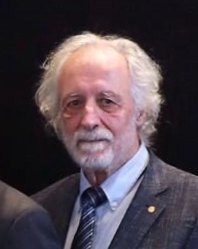Pierre Agostini
French physicist
Pierre Agostini (French pronunciation: [pjɛʁ aɡɔstini]; born 23 July 1941) is a French experimental physicist. He is an Emeritus professor at Ohio State University. He is known for his work in strong-field laser physics and attosecond science.[1] He is also known for his invention of the reconstruction of attosecond beating by interference of two-photon transitions (RABBITT) technique.[2] He was jointly awarded the 2023 Nobel Prize in Physics.[3]
Pierre Agostini | |
|---|---|
 Agostini in 2023 | |
| Born | 23 July 1941 |
| Alma mater | Aix-Marseille University (BEd, MAS, PhD) |
| Known for | Above-threshold ionization RABBITT |
| Awards | Gay-Lussac–Humboldt Prize (2003) William F. Meggers Award (2007) Nobel Prize in Physics (2023) |
| Scientific career | |
| Fields | Attosecond physics |
| Institutions | CEA Saclay Ohio State University |
| Thesis | Appareillage permettant la réalisation de filtres multidiélectriques UV: Étude des couches Sb2O3 cryolithe (1967) |
| Website | physics |
References
change- ↑ Agostini, Pierre; DiMauro, Louis F (1 June 2004). "The physics of attosecond light pulses". Reports on Progress in Physics. 67 (6): 813–855. Bibcode:2004RPPh...67..813A. doi:10.1088/0034-4885/67/6/R01. ISSN 0034-4885. S2CID 250879086.
- ↑ Garisto, Daniel. "This Year's Physics Nobel Awards Scientists for Slicing Reality into Attoseconds". Scientific American. Retrieved 2023-10-04.
- ↑ "Nobel Prize in physics goes to Pierre Agostini, Ferenc Krausz and Anne L'Huillier for research into electrons in flashes of light". CNN. 3 October 2023. Retrieved 3 October 2023.